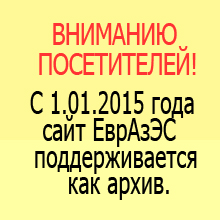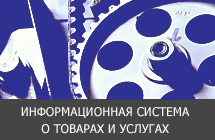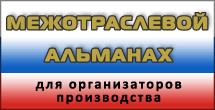|
CONCEPT of Establishment of the Сommon Transport Space of the Eurasian Economic Community Approved by Resolution of the EurAsEC Interstate Council 25 February 2008, No. 374
CONCEPT of Establishment of the Сommon Transport Space of the Eurasian Economic Community
Introduction
The Eurasian Economic Community (EurAsEC) is an international organization created to effectively realize goals and objectives defined in the Agreement on a Customs Union, dated 20 January 1995, the Treaty on the Deepening of Integration in the Economic and Humanitarian Fields of March 29, 1996, and the Treaty on a Customs Union and a Single Economic Space, dated February 26, 1999. The Community was created to ensure the dynamic development of its Member States by means of coordinated social and economic transformations and effective use of their economic potential for the sake of improving the standards of living of the EurAsEC Member States’ populations. One of the Community’s economic policy objectives declared by the Heads of the EurAsEC Member States is the establishment of a common market in transport services and of a unified transport system. It is feasible only on the basis of a Common Transport Space (CTS) which is understood as an aggregate of transport systems of the EurAsEC Member States, aimed at unimpeded movement of passengers, baggage, cargo and conveyances and ensuring both technical and technological compatibility of transport processes, a harmonized transport-related legislation and common competition rules. The CTS embraces the activity of all types of transport and applies to the suppliers of transport and auxiliary services related to traffic organization, independently of their type of ownership and country of establishment. The elaboration of this Concept stemmed from the need to reach a common understanding of the goals, objectives and order of actions and to work out a unified approach by the Community States to the procedure for integrating a unified transport system in the context of establishing a common market for transport services. The Concept takes into account the following fundamental conditions and objectives resulting from the logic of transport systems development and the analysis of the state of the transport industry in the EurAsEC Member States, the provisions of the Agreement on the Establishment of a Transport Union, dated 1998, the decisions of the EurAsEC Interstate Council, the experience of CTS establishment and transport integration within the European Union (EU), the North American Free Trade Agreement (NAFTA), the Andes Community and other integrated associations. 1. Transport operations and development in the Community Member States are conducted in accordance with their legislation in force and reciprocally linked to long-term forecasts of their social and economic development, determining the need for transport services and improvement of their quality. The unity of the transport space is guaranteed by coordination by all the Community Member States of conditions and requirements of the State regulation and realization of its development programs, by an efficient unification of the transport-related and general economic (horizontal) legislation and by a coordinated use of the transit and transport potential and development of the transport machine-building. The CTS establishment takes account of differences in the present state of the EurAsEC Member States’ transport complexes and contributes to leveling them out. 2. The EurAsEC States carry out a coordinated policy aimed at protecting the interests of the EurAsEC transport industry in the world transport services market and applied when working on transport development issues in international organizations and at international forums. 3. Transport enterprises of all types of ownership generally develop and function on commercial lines as peer subjects of the transport services market of individual States or the whole Community. The conditions for admission to the transport services markets for enterprises and entrepreneurs and the market rules in the Community Member States are established by the State organs of these countries, which also exercise the necessary supervision of compliance with the above conditions and rules. In this area, the Community Member States are also governed by common agreed principles. 4. The operation and functioning of the transport systems are considered
not only as a means of satisfying passenger and cargo traffic demand that can
be paid for, meeting environmental, defense and other specific requirements,
but also as an important factor contributing to the expansion of domestic and
interstate relations in the Community. They make for a better realization of
geographical benefits of the Community Member States in transit and transport
and economic relations between Europe and 5. The EurAsEC CTS is established with regard for the interconnection of all its necessary components, such as: taxation and tariff policy, common rules of competition, national treatment as regards the establishment and functioning of transport companies, migration policy and the use of professional labor. 6. Measures to establish the CTS are coordinated with the activities
relating to the creation of a Customs Union and the elimination of internal
borders within this 7. The CTS establishment takes account of the Community Member States’ international commitments while acknowledging the supremacy of the international norms and standards stipulated in multilateral agreements and conventions of CIS, ICAO, IMO, UNECE, UNESCAP and other international organizations. Every country will be afforded non-discriminatory access to international transport corridors.
1. Establishment of the EurAsEC Common Economic Space: goal, objectives, principles
In establishing the CTS, the goal is to create conditions ensuring the provisioning of transport services for unimpeded movement of passengers, cargo and conveyances on the whole territory of the Community based on the guaranteed unity of transport systems and processes. Establishment of the CTS would achieve the following main objectives: 1) efficient harmonization of the statutory legal regulation of transport activity, unification of technical standards and transport technologies in the Community Member States, including on the basis of the EurAsEC international norms and multilateral transport-related agreements and conventions adopted at the international level; 2) elimination of any discrimination against suppliers of transport services when they transport passengers or cargo in EurAsEC Member States different from the Community State they are established in, as well as in licensing, certification and establishment of transport companies, their branches and representative offices or joint ventures on the whole CTS territory, i.e. conformity of national treatment; 3) guaranteeing free transit of passengers and cargo, efficient use of the Community Member States’ transit and transport potential; 4) transition to the Community multilateral agreements on air communication (“open sky”), international road transport communication, navigation in inland waters etc; 5) maximum use of positive experience with the integration of transport systems within the Community of Independent States, especially in the area of railway transport and civil aviation and airspace use; 6) creation of consultation mechanisms within the Community to coordinate external economic transport-related policy; 7) technical re-equipment of transport systems in order to considerably improve the use of EurAsEC Member States’ transport potential, efficiently serve their population and economy, and ensure transport safety and security and preservation of the environment to the full extent; 8) unification of the tariff policy formation principles and taxation conditions as regards conveyances and transport services; 9) unification of the conditions of compulsory insurance of the civil liability of carriers to passengers and conveyances’ owners to third party; 10) ensuring free access for professional labor to the transport services market and joint training of staff; 11) realization of a common policy for transport safety, transport operations security and reduction of the negative effect of transport on the environment; Establishment and operation of the CTS is based on the following principles: 1) CTS compliance to be established with the norms and principles of international trade adopted within the World Trade Organization (WTO). Therefore it is necessary to inform the WTO of an integration process within the EurAsEC in accordance with the criteria of the GATS Articles V Economic Integration and V-bis Labor Markets Integration Agreements. The CTS establishment measures shall be implemented with regard for fulfillment by Community Member States of the provisions of the EurAsEC multilateral Agreement on Trade in Services; 2) supremacy of international treaties and EurAsEC norms over legislative enactments and normative legal acts of the Community countries; 3) transparency of norms of the transport-related statutory legal and technical regulation in all the EurAsEC Member States, including the licensing procedures and criteria for suppliers of transport services, supervision of their activity, appointment of carriers and implementation of other measures; 4) openness for discussion of any measures on CTS establishment and operation, transport policy pursued by the EurAsEC and existing restrictions and violations; 5) access to the dispute settlement mechanism as a right for all participants involved in the transport market, to the fair settlement of disputes that may arise and discrimination cases in respective EurAsEC structures. 2. Present state and relation of the EurAsEC Member States’ transport complexes
2.1. State of the EurAsEC Member States’ transport complexes and transport and economic relations The CTS is to be established on a territory with a surface of more than
20 million sq km and population of 280 million people. It embraces all types of
main-line transport carrying passenger and cargo traffic both within the
Community and between the In 2001–2005 the volume of mutual foreign-trade turnover of the EurAsEC Member States increased more than twice and exceeded 30 billion US dollars. The total turnover of goods between the Community Members (except the pipeline turnover) in 2005 reached 235 million tonnes, against 120 million tones in 2000. Most of the international cargo traffic is performed by railway, pipeline and automotive transport. Passenger transport is by rail, road and civil aviation. Sea transport accounts for a considerable part of the
foreign-trade traffic between the Road and rail traffic within the Community is carried out through the
border crossings agreed by the Transit traffic, including in the context of the EurAsEC Member States’
mutual relations and their relations with third countries, has exceeded 117
million tones (in 2000, 50 million tones). In particular, almost the whole
volume of cargo traffic between the The EurAsEC Member States’ transport systems play little part in transit
cargo traffic in Eurasian communications: its volume does not exceed 2 million
tones (in 2000, 1 million tones), including traffic between the countries of
Eastern and South-Eastern Asia and In 2006 the joint transit potential of the EurAsEC Member States was estimated at 230 million tones, and its actual use amounted to approximately 50%. At the same time, by 2020 the joint transit potential will grow to 430 million tones. The volume of the mutual cargo traffic can increase 1.87 times by 2020 against 2005 and reach 490 million tones, and the volume of passenger traffic 1.9 times. At present the Community has a common railway space functioning de facto and coordinated by the CIS Railway Transport Council, and an air space harmonized to a fairly large extent. The Community ensures the application of common standards for railway transport and common airworthiness standards supported by the Interstate Aviation Committee (IAC), certification rules for aviation equipment, civil aerodromes and their equipment etc. The CTS establishment will require considerable improvement in the state of the transport infrastructure subjects providing interstate connections, and the conveyance characteristics critical for the efficiency and compatibility of technologies as well as traffic safety and security will need to be updated. In this regard efforts should be focused on the elimination of barriers (infrastructural and technical) arising in the process of interstate transport activity.
2.2. Main barriers to the transnational movement of passengers and cargo Experience of international transport-related cooperation has made it possible to identify barriers impeding the development of transnational relations. These barriers can be consolidated in the following main groups: – infrastructural – absence of essential elements of the infrastructure which would have required in particular good-quality roads with proper facilities and border check-points; – technical – unacceptable state of both conveyances and service infrastructure, and differences in technical requirements to them; – regulative (administrative) – differences in permit systems, quotas assignment, licensing, insurance, supervision and labor recruitment conditions; – trans-border – obstacles at the borders between Community countries and with the outside world, numerous pre-delivery inspections and control procedures; – fiscal – levying of state duties and illegal tolls exacted on the roads. According to expert evaluation, the cargo carriers’ joint losses caused by these barriers on Community territory amount to 845 euros per average statistical round trip. The barriers also complicate carriers’ work on other conveyances. On the whole, considering the total number of conveyances in the Community, joint losses amount yearly to tens of millions of euros. In passenger and cargo traffic between the Community
Member States the existence of infrastructural barriers is due to the state of
infrastructure subjects, primarily to the state of roads and border
check-points. Infrastructural barriers also hinder the railway and inland
waterway traffic between the Technical barriers still hindering the traffic between EurAsEC Member States are due to the state of conveyances and differences in standards. These barriers are most noticeable in road traffic and are caused by a lack of harmonization of the requirements for limitations on vehicles’ fully loaded mass, dimensions and axle load, insufficient quality of technical service on the roads etc. A system of transport and logistics complexes for general use is almost non-existent. A common problem as regards the state of the EurAsEC Member States’ transport systems is extensive (up to 70%) deterioration of their key assets and technical and physical ageing of all types of conveyances. A considerable proportion of vehicles do not meet international environmental requirements, which limits their use in international passenger and cargo traffic. The transnational and transit passenger and cargo traffic and access to the transport services market reveal differences in the legislative and statutory legal bases of the EurAsEC Member States, and namely, in: – legal acts regulating transport activity (codes, statutes, laws on transport); – procedures for admitting suppliers of transport services to the market; – limitations on the foreign investment share in the authorized capital of transport companies; – nature and level of limitations and bans on transport companies’ personnel recruitment; – uncoordinated accession to international agreements and conventions on transport, and the fact that respective international rules are reflected in national legislations and statutory legal bases. Besides, as regards transport relations between EurAsEC Member States are still based on bilateral intergovernmental agreements giving preference to the countries which signed these agreements and are in fact discriminatory towards the other EurAsEC Member States. This leads to the absence of a permit-free system of passenger and cargo traffic in two-way and transit communications between individual EurAsEC Member States. Legislative problems cause non-physical barriers having regulative (administrative) significance, especially in limiting suppliers’ access to the rendering of services. Traffic is subject to national identity requirements, a permit system and quota allocations; there are differences in the procedures of licensing, insurance, labor hiring and residence; and control procedures can be unnecessarily complicated. A particular role is played by fiscal barriers in the form of diverse local duties, specifically road tolls, transit fees, environmental duties and fees for customs support etc. For virtually all the EurAsEC Member States there is a real danger of professional labor shortage in the transport sector, which makes the issue of personnel education and advanced training especially topical. Barriers at the EurAsEC countries’ borders impede the development of transnational traffic within the Community and with third countries. The trans-border barriers cause stoppages at border check-points due to unjustified customs inspections, pre-delivery inspection, the need to obtain transit permits and numerous sanitary, veterinary and phytosanitary restrictions. The existing barriers increase the cargo weight and the price of transported goods, reduce the quality and increase the cost of travel, and, on the whole, lower the efficiency of passenger and cargo traffic and have a negative impact on trade and tourism. The existing transport potential and the advantageous geographic position of the EurAsEC Member States are not sufficiently used for the development of transport services export, including on Europe-Asia lines. The elimination of the above barriers should be carried out only in the context of coordinating the Community States’ interests and activities related to protection and joint promotion of the interests of the national transport systems and the Community’s common transport system on the world market.
3. Establishment of the Common Economic Space: priorities
It is proposed to define the following priorities in establishing the CTS, as the focus of public financing: – creation of a common market of transport services; – creation of a common transport system; – realization of the EurAsEC Member States’ transit potential; – development of a system of the Community’s logistics centers. 3.1. Creation of a common transport services market The fundamental factor in the CTS establishment is the creation of equal
competition conditions for all For that purpose EurAsEC Member States’ transport companies operating on the territory of other EurAsEC Member States, including auxiliary and back-up services (repairs and servicing of conveyances, forwarding, logistics, marketing etc.) should be granted operating conditions which are no less favorable than those in force for analogous national companies. While creating a common market of transport services, the major activities should be: 1) ensuring the freedom of transit for international passenger and cargo traffic; 2) harmonizing the conditions for passenger and cargo traffic between
the 3) coordinating the procedure and organization of the supervision of conveyances entry (exit), including third countries’ conveyances, at the Community external borders; 4) implementation by Community countries of a coordinated foreign-trade transport-related policy pursued by the States on the international scene; 5) adopting common approaches to competition development and unfair competition prevention, including the harmonization of licensing systems and consolidation of joint efforts aimed at preventing third countries’ unfair competition practices; 6) mutual acknowledgement of certificates, diplomas and other documents regulating access to transport activity; 7) creation of a common system of information support for the transport services market, transport statistical accounting and conditions for the exchange of information on technical and operational characteristics of international transport corridors. The CTS establishment should provide for the realization of the following measures related to the legislation and statutory legal basis: 1) harmonization (including on the basis of supranational regulation) of the transport-related legislative and statutory legal base of the EurAsEC Member States; 2) elaboration and adoption of multilateral agreements on international road, rail and air communication, maritime shipping, inland waterway shipping etc, instead of the bilateral intergovernmental agreements in force within the EurAsEC; 3) elaboration of common approaches to the establishment of relations with third countries; 4) consistent joint work aimed at the elimination of barriers for mutual access to the passenger and cargo traffic market and related auxiliary and back-up services; 5) use of the existing EurAsEC instruments for transport sector regulation, with a compulsory equal legal effect for all the Member States. In order to realize the above provisions, the EurAsEC Member States should complete their work on accession to the basic multilateral CIS documents and transport-related international agreements and conventions by UNECE, UNESCAP, ICAO, IMO etc., and bring the national legislative and statutory legal basis into line with them. As regards international railway communications, the envisaged activities include preservation and strengthening of the common market of railway transport services, coordination with the CIS Railway Transport Council and establishment of a CTS railway transport sector. As regards international road and sea traffic and inland water transport, the following measures should be taken: 1) granting of national treatment to transport companies, signing of multilateral agreements determining the order and conditions for traffic within the Community; 2) introduction of necessary amendments in national legislation and statutory legal bases, aimed at securing the economic integration within the EurAsEC; 3) as regards international road traffic on the territories of the EurAsEC Member States: elimination of the permit system, any quotas, tariff and other restrictions; relations between the Parties as regards international road traffic to/from third countries are regulated on the basis of the bilateral agreements concluded; 4) as regards inland waterway transport: stage-by-stage ensuring access for river boats and river-sea navigation vessels to navigation under the flag of the EurAsEC Member States in national inland waters. As regards civil aviation and airspace use, provision should be made for the following: 1) preservation and strengthening of cooperation within ICAO, the CIS Civil Aviation Council and IAC in all the various activities of these international organizations; 2) taking measures in order to expand carriers’ commercial possibilities to carry out communications between Community Member States, by means of mutual recognition of carriers by national aviation authorities in respect of ownership and activity supervision, and providing carriers with permits to fly within the CTS; 3) signing of a EurAsEC multilateral agreement on air communication (“open sky”) which, within its scope and without prejudice to flights and aviation security and safety, will eliminate restrictions on flight itineraries and frequency, aircraft capacity, tariffs and parity criteria applying to air communications, in strict accordance with the ICAO policy and recommended practices on the international air communications liberalization; 4) introduction of amendments and supplements to national air legislation and the statutory legal basis, aimed at realizing economic integration within the CTS.
3.1.1. Establishment and functioning of transport companies To eliminate restrictions on the right to perform economic activity in the form of a commercial presence in any of the EurAsEC Member States, to attract investment in transport business development, to open subsidiaries and branches of transport and transport-related services suppliers, it is proposed that the EurAsEC Member States mutually grant national treatment regarding the establishment and functioning of companies involved in transport activity and rendering of auxiliary and back up services related to the organization of international traffic. At the first stage of establishing the CTS the present provision will not apply in full to the establishment of companies in railway transport and civil aviation sectors. As regards railway transport, the EurAsEC Member States will be able to keep a 100% State share in the joint stock of their national companies involved in passenger and cargo traffic and the rendering of infrastructure services. In the civil aviation sector the EurAsEC Member States will have the right to keep a restriction on foreign investors’ share in the joint stock of aviation organizations. A lower level of restrictions on companies’ establishment and ownership in the railway transport sector is proposed for the next stages of the CTS establishment. All the transport companies established on the territory of any To implement national treatment applying to transport companies’ establishment and operation, the following provisions should be harmonized: 1) of Civil Codes and other acts of law of the EurAsEC Member States related to access to the provision of services on a commercial basis; 2) of legal acts, by transport types, while excluding from these restrictions (or introducing amendments concerning the EurAsEC Member States) on the size of foreign share in transport companies’ authorized capital. 3) of normative legal acts on the licensing of suppliers of road, inland waterway, air, railway and sea transport services, including auxiliary and back-up services (transshipping, servicing, repairs etc).
3.1.2. Establishment of a unified tariff policy As regards the tariff policy, the following activities are proposed in the context of establishing the CTS: 1) improvement of the tariff system in accordance with the EurAsEC multilateral transport-related agreements and international agreements and conventions; 2) guarantee of free pricing in competitive sectors of transport services; 3) indexation of tariffs for transport services of the subjects of natural monopolies is performed in accordance with the parameters of the EurAsEC Member States social and economic development and financial plans of the subjects of natural monopolies in the transport sector; 4) compensation to the subjects of natural monopolies for economically justified expenditures and the rate of return (profit) if they carry out socially important transport, including the transportation of certain categories of citizens (in accordance with an agreed list) and their baggage in communications between EurAsEC Member States; 5) determination of compensation sources if the established tariffs, fares and duties for transport services by the subjects of natural monopolies do not provide for an established level of traffic profitability; 6) coordination of tariff regulation measures with other promotion and restrictive measures in the transport sector; 7) ensuring tariff stability during periods agreed upon by Parties. The following measures are proposed according to the types of transport: As regards railway transport, unification of: 1) fare construction methodologies; 2) methodologies for traffic prime cost and rate of return calculation, as a base for the agreed tariffs establishment; 3) internal and external nomenclatures of shipped cargo; 4) tariff differentiation principles; 5) tariff currency; 6) tariff structure; 7) a list of works and services paid at the rates of complementary fares and duties; 8) mechanisms for compensating profit losses of organizations providing railway transport for general use, due to the application of a reduced tariff; 9) calculation methodologies as applied to the establishment of through tariff rates. As regards air transport, unification of: In the monopolistic sector: 1) airport tariffs and duties, including: – a nomenclature of services provided by airport services ensuring aircraft servicing, take-off and landing; – principles of establishing airport tariffs level and rentability. 2) methods of calculating the level of duties for air navigation service: – en route; – at the aerodrome. 3) tariff currency. In the competitive sector: 1) methods of calculating tariffs and duties for passengers, cargo, post and baggage transportation; 2) principles of establishing exclusive (reduced/increased) tariffs. For road transport: 1) the harmonization of normative legal acts governing relations between carriers-customers and standards-norms and determining an operating procedure for the tariff policy; 2) unification of internal and external nomenclatures of shipped cargo; 3) elaboration and application of a common method of calculating the lower level of “recommended” tariffs. As regards water transport (monopolistic sector – river and seaports), the unification of: 1) a list of services registered in river and seaports, when vessels call at a port for freight operations and then leave the port; 2) cargo classification for calculation of tariffs for handling operations in seaports.
3.1.3. Optimization of the transport cost element in the price of goods The main measures for optimizing the transport cost element in the price of goods are: 1) diversification of the EurAsEC Member States’ production structure and accelerated development of science-intensive and non-material-intensive sectors; 2) cutting down the share of non-concentrated raw materials traffic and increase in the share of more expensive and less transport-intensive goods with a high added cost in the Community Member States foreign-trade turnover; 3) large use of through tariff rates in interstate trade and transport relations; 4) establishment of exclusive tariff conditions in accordance with the General Principles of Railway Tariffs Establishment and Application and the Procedure for Establishing Reduction Factors and Through Tariff Rates for cargo traffic between railway stations of the EurAsEC Member States, ratified by the EurAsEC Interstate Council Resolution (at the highest level) dated 19 May 2006, No. 290, including traffic of socially important cargo (products); 5) implementation of a flexible tariff policy, also by means of a territorial tariffs differentiation within contiguous regions of the EurAsEC Member States, making it possible to concretize to the maximum the levels of fares and freights and the share of the transport element in the prices of goods and to increase goods competitiveness on the world markets; 6) adoption by the EurAsEC Member States of an agreed methodology for a unified system of calculating transport costs for tariff purposes and establishment of a limit benefit-cost level, where the cost is calculated using the adopted methodology; 7) creation within the EurAsEC of a specific body invested with the authority (or widening of the authority of an existing body) for realizing a flexible tariff and financial transport-related policy, with a clear definition of issues delegated to this body by Community countries.
3.1.4. Harmonization of taxation systems for suppliers of transport services To create equal competitive conditions for suppliers of transport and transport-related services within CTS, it is proposed that the EurAsEC Member States coordinate their transport-related fiscal policy at the Community level along the following lines: – tax rate unification; – double taxation elimination; – regular (prompt) information exchange between the States’ tax services concerning the supervision of transport services suppliers. Transport-related fiscal policy should focus on simplifying the tax structure and reinforcing its investment orientation, reducing the total taxation burden and stimulating efficient activity of the transport sector subjects. It should ensure the following: 1) coordination of a unified list of main taxes, common principles and rules of taxation for transport and transport-related services suppliers, and establishment of unified terms and notions; 2) compliance of the main principles of taxation for transport enterprises in the EurAsEC Member States with the taxation principles used in world practice.
3.1.5. Unification of norms and requirements for personnel transfer, recruitment and training In order to ensure efficient functioning of the CTS, the Community Member States should guarantee free movement of professional labor (pilots, drivers, vessels and engine crew members and other specialists, company heads and managers) throughout CTS territory. To achieve this objective, the Community countries should: 1) mutually recognize diplomas, certificates and other documents confirming the professional competence of transport company personnel and issued on the territory of other EurAsEC Member States; 2) allow transport companies to transfer their professional and key personnel to work in their subsidiaries and branches located on the territory of other EurAsEC Member States, in accordance with the legislation of these States; 3) grant citizens of other EurAsEC Member States that are professional specialists or key personnel of transport companies and legally recruited, treatment which excludes discrimination against their citizenship as regards working conditions, remuneration or dismissal, as compared to their own citizens; 4) introduce amendments and supplements in their national legislative acts and normative legal acts at the last stage of CTS establishment in order to give equal status to citizens from other EurAsEC Member States in their rights to professional activity with national transport services suppliers. The possibility for citizens from other EurAsEC Member States to take up the post of master or that of other river and maritime vessel specialist and to join an aircraft crew should be regulated by a specific EurAsEC Agreement. The most important measures in personnel policy should be to elaborate and realize programs of joint education and advanced training of professional and key personnel for all types of transport, to unify education programs in compliance with respective international standards of professional education, to monitor education quality and to provide joint academic and methodical support. The above measures should be realized in coordination with the establishment of the EurAsEC common labor market and the Community’s agreed migration, social and education policy by the creation of an interstate database on labor supply and demand.
3.2. Establishment of a common transport system The top-priority activities of the establishment of a common transport system are: – improvement of the transport infrastructure, material and technologies of passenger and cargo transport – establishment of a coordinated policy for transport and traffic safety and security and environmental protection
3.2.1. Improvement of transport infrastructure and material and passenger and cargo traffic Transport technical re-equipment is a crucial objective in establishing the CTS and the key to successfully improving the use of EurAsEC Member States’ transport potential, providing efficient services to the Community’s population and economy, and ensuring traffic safety and security and environmental protection to the full extent. The unity of transport space is ensured by establishing a system of EurAsEC international transport corridors, including infrastructure subjects of all types of transport and their conditioning. To efficiently improve the technical standards of transport, the following measures are proposed: To develop and improve the transport infrastructure, the following measures are proposed: 1) interstate coordination of national programs of development for transport communications included in the list of EurAsEC transport corridors; 2) consistent elimination of weak points and other failings of the transport infrastructure in order to ensure that in every EurAsEC Member State all points of cargo and passenger traffic origination and destination are equipped with infrastructure subjects of the types of transport and technical level that are required there for economic or other reasons; 3) modernization of the existing infrastructure subjects of the EurAsEC international transport corridors and their gradual and full adjustment to the requirements of the European Agreement on Main International Traffic Arteries (AGR) of 1975, European Agreement on Main International Railway Lines (AGC) of 1985, European Agreement on Main Inland Waterways of International Importance (AGN) of 1996, European Agreement on Important International Combined Transport Lines and Related Installations (AGTC) of 1991, Interstate Agreement on Asian Main Roads of 2004, Interstate Agreement on the Trans-Asian Railway of 2006 and Convention on Road Traffic, Road Signs and Signals of 1968. As regards conveyance standards and technical parameters, the following activities are proposed: 1) elaboration and maintenance of unified usability norms for all types of conveyances, taking account of efficient operating life of transport means and their main units; 2) elaboration of a common strategy of transport safety and security, aimed at continuous reduction of traffic accidents; 3) introduction of unified norms on the emission of harmful substances, environmental noise, navigation accuracy and vehicle axle load, in compliance with the respective international standards; 4) adjustment of technical standards for conveyances and their equipment to the requirements of the International Standards Organization (ISO), the International Electro-technical Commission (IEC) and international agreements and conventions concluded within ICAO, IMO, UNECE and CIS; 5) consideration of realistic possibilities and particularities of the EurAsEC Member States’ transport systems in the process of realizing measures elaborated within the CTS; 6) coordination of the interests of the Community transport system in international institutes as regards conveyance standards and technical parameters; 7) adjustment of weight, dimensions and other technical requirements for the conveyances involved in international passenger and cargo traffic within the EurAsEC and between Community Member States and third countries to the requirements of conventions and agreements concluded within ICAO, UNECE and CIS; The following measures are proposed in order to improve the technology of passenger and cargo traffic: 1) elaboration and application of unified standards and standard technological processes; 2) development of multimodal, container, controller and unitized loads transportation, creation of terminal and logistics complexes; 3) introduction of mechanisms designed to enhance the efficiency of transport systems operation based on the use of modern logistics and information technologies; 4) introduction of global river, sea, air and road navigation based on the use of satellite-aided tracking and positioning systems; 5) development of high-speed passenger traffic; 6) application of modern transport and customs technologies at the external borders of the EurAsEC Customs Union in order to accelerate control procedures, especially as regards socially important cargo (humanitarian aid, perishables etc); 7) creation of national and transnational forwarding companies; 8) elaboration, establishment and implementation of common databases containing timetables of the conveyances involved in passenger traffic, passenger and cargo tariffs, fares and duties, licensing and qualification requirements and other information affecting the interests of transport services users and suppliers; 9) measures to ensure traffic safety and security and environmental protection (including prevention of ethnogeny and man-made emergencies); 10) unification of the requirements, rules and technologies on the basis of the accession of the EurAsEC Member States to transport-related conventions and agreements by UNECE, ICAO and IMO; adjustment of the legislative and statutory legal basis to their requirements. To satisfy the growing demand for quality transport services, it is necessary to strengthen the innovative trend in EurAsEC Member States’ transport development on the basis of an active and coordinated scientific and technical policy. The tasks of improving the technical standards of transport and using state-of-the-art technologies should be accomplished by elaborating and implementing new conveyances and engineering facilities ensuring lower resource-intensiveness, higher economy, security and safety, ergonomics and environment-friendliness of the transport process. The transport-related technical policy should give preference to the transport material and equipment made by EurAsEC Member States producers, meeting international standards, on the basis of evaluation of their elaboration and production prospects. To this end, it is necessary to create both a system of economic incentives for the production and exploitation of the most efficient and environment-friendly material, and mechanisms of coordination for economic interests of investors, creators, producers and users of new transport material.
3.2.2. Establishment of a coordinated policy for transport and traffic security and safety and environmental protection The following activities are proposed in order to carry out a range of measures to ensure environmental protection and transport and traffic security and safety, which become more important with the increase in traffic volume, the deterioration and accumulation of outmoded conveyances, and the toughening of requirements for transport security, safety and environment-friendliness: 1) constant supervision of the conveyances’ technical state, implementation of modern diagnostics systems and observance of their standard use requirements, increase in these requirements’ significance in the certification of conveyances and the licensing of transport activity; 2) legal and financial guarantees that preventive routine repairs will be done at transport infrastructure subjects that are potential centers of large-scale ethnogeny disasters; 3) regular renewal of the fleet with promising conveyances that meet modern ecological standards; 4) writing-off and recycling of transport material if repairs and running maintenance cannot ensure the necessary level of reliability and environment-friendliness; 5) increasing the proficiency and responsibility of personnel servicing the transport material who are responsible for its condition; 6) enhancing measures for transport protection against unlawful interference in its activity and against terrorism; 7) persistent elaboration and realization of specific programs and individual actions aimed at improving environmental protection and transport and traffic security and safety, including the sector of transport mechanical engineering and the recycling of transport material unsuitable for operation.
3.3. Realization of the Community joint transit potential The prospective core of mutual cargo traffic will be fuel and energy and construction goods, as well as metals. The shipped volumes of chemical products and foodstuffs will increase considerably. At the same time, the EurAsEC Member States’ economic growth and economic diversification will contribute to an increase in the share of container traffic. It is forecast that by 2020 mutual transit cargo traffic between Advance development of the transport and logistics infrastructure will be needed before 2020 to ensure the growth of EurAsEC Member States’ transit potential. Transit shipping volumes will rise due to the growth of EurAsEC Member States’ mutual transit in communications with third countries and transit cargo traffic between third countries on the Community territory. In general terms, by 2020 the total volume of transit
traffic on Construction of new railways and roads and reconstruction of the
existing ones, development of the Aktau port and the construction of new seaports
will increase the transit potential of the Both the development of the Community Member States transport systems and the establishment of the CTS imply consistent integration into the world transport system, which presupposes: 1) widening of transport services export and representation of the
interests of 2) realization of Community Member State transit potential by increasing the attractiveness of their ground communications, sea and air space for third countries’ international transit passenger and cargo traffic; 3) development of Eurasian transport corridors on 4) cooperation and coordinated participation in transport-related international projects and programs on Community territory. The transit traffic increase will be provided by: 1) railway, road, water and multimodal transit cargo traffic through the development of the Eurasian transport communications infrastructure and, first of all, North-South and West-East corridors; 2) railway transit shipping by means of a larger number of high-speed container and controller trains and their logistics, and an increase in the respective capacities of seaports; 3) transit shipping by river and sea transport towards the Azov-Black Sea and Baltic sea basins through a gradual opening of Russia’s inland waterways for ships navigating under the flags of the EurAsEC Member States; 4) transit passenger and cargo traffic by air transport through the creation of a hub airports network; 5) creation of specialized container terminals; 6) establishment of integrated subjects of a multimodal transport and logistics system to ensure foreign-trade and transit shipping. Realization of the above priorities meets the need to harmonies Community Member States’ interests with regard to the admission of transit passenger and cargo traffic with maximum use of their national transport infrastructure subjects. Development of infrastructure and transit potential before 2020 will focus on the following main transport lines: – establishment and development of the Eurasian corridor: – development of the North-West transport line (South Asia – EurAsEC
Central Asian States – – development of the South-West transport line (South Asia – EurAsEC Central Asian States – Russia – ports of Russia and Ukraine/Eastern European States); – development of the Eastern transport line (Central Asia/Belarus – Russia – ports of the Primorsky Krai – APR countries with offshoots to Mongolia, China and the Korean Peninsula, the Transsib Eurasian corridor).
3.4. Development of a system of logistics centers within the Community Development of transport infrastructure on At the first stage – before 2012 – transport and logistics centers will be created in: – the – the – the – the Russian Federation – in Moscow and St Petersburg TNs, Nizhny Novgorod, Samara, Volgograd, Novorossiisk, Kaliningrad, Murmansk, Ekaterinburg, Krasnoyarsk, Irkutsk, Khabarovsk, Vladivostok/Nakhodka; – the At the second stage – before 2020 – it is intended to create transport and logistics centers in: – the Republic of Kazakhstan – in Uralsk, Aktob, Semipalatinsk, Kzylorda, Taraz, Shymkent and Korgas, Taskala and Bakhty border control points; – the – the – the Russian Federation – in Arkhangelsk, Vologda, Smolensk, Ryazan, Tver, Yaroslavl, Bryansk, Orel, Lipetsk, Tambov, Kazan, Perm, Saratov, Astrakhan, Krasnodar, Rostov-on-Don, Ufa, Orenburg, Chelyabinsk, Barnaul, Tyumen, Omsk, Ulan-Ude, Chita; – the – the The total volume of investments in the creation of a transport and logistics system on the EurAsEC Member States territory before 2020 is estimated at 12.5 billion dollars, with financing from off-budgetary sources.
4. Establishment of the Common Transport Space: stages
The CTS should be established stage-by-stage, taking account of particularities in integration process within the EurAsEC Common Economic Space and Customs Union, and the level of economic development of individual Member States. At the first stage (2007–2010), it is proposed to harmonies the transport-related part of the legislative and statutory legal basis of the EurAsEC Member States and to prepare drafts of EurAsEC's most important multilateral agreements ready for discussion, coordination and signing. At this stage the EurAsEC Member States will complete the process of accession to the most important international agreements and conventions defining the conditions of transport operation, their ratification and application of traffic norms, standards and technologies unified at the international level. At the second stage (2010–2015), CTS establishment will be linked to the process of horizontal integration within the EurAsEC and completed establishment of the Customs Union and Common Economic Space, including the leveling-off of management economic conditions and competition rules, and the harmonization of tariff, taxation, labor, social and other regulation schemes. At this stage, the Community Member States will take measures to grant national treatment to transport service suppliers from the EurAsEC Member States as regards both international passenger and cargo traffic, and transport companies’ establishment and operation. The existing transport-related bilateral interstate agreements will be replaced by EurAsEC multilateral agreements. At the third stage (2015–2020) the establishment of the EurAsEC Common Transport Space will be completed with the creation of a transport service common market and a common transport system. The common activity for all the stages of CTS establishment will be the actualization of national transport-related programs and projects in order to elaborate coordinated actions aimed at the development of the following: transport, logistics, telecommunications and navigation infrastructure; fleet; subjects of State supervision; servicing; other services; the EurAsEC Member States’ transit potential. It is advisable to perform this activity within the elaboration and
realization of special interstate programs and projects which should also
include measures supplementing national programs and aimed at resolving the
most important transport-related common issues on
5. Investment policy
With regard to the investment policy within the CTS, which should ensure the conditions for a normal and timely renewal of transport infrastructure subjects and transport engineering facilities by stimulating use of the most efficient, safe, secure and environment-friendly conveyances and technologies, the following activities are proposed: 1) development of the infrastructure of all types of conveyances at the main lines of interstate passenger and cargo traffic, including the development of international transport corridors ensuring Eurasian transport and economic connections; 2) elimination of gaps and weak points in the network development, raising the technical standard of roads; 3) elimination of regional discrepancies in the development of 4) advance creation of carrying capacity reserve at those communications between the EurAsEC Member States where the highest growth of passenger and cargo traffic is forecast; 5) accelerating the establishment of an integrated transport and logistics system as the basis for a prospective development of intermodal traffic both at international transport corridors and in large economic centers; 6) financing of operations aimed at transport development and improvement, predominantly at the expense of transport enterprises and structures’ own means, which requires measures aimed at the increase of their investment potential and their interest in its efficient exploitation. At the same time, investment policy within the CTS should ensure that: 1) transport has greater investment appeal for private capital; 2) large projects on transport development and improvement are implemented generally on the basis of EurAsEC special programs; 2) maximum resources are injected into EurAsEC priority projects in order to accelerate their realization in every possible way. There are grounds for establishing a system of public-private
partnership entailing, among other The priority investment projects on transport lines development are: In the At the Eurasian transport corridor – repair of the motorway M-1/E-30 Brest (Kozlovichi) – – development of railway national border crossing points in 2008–2015, cost – 113.3 million dollars, financing from Belorussian Railway’s own funds (60%) and the State budget (40%); – switchover of the sector In the At the Eurasian transport corridor – construction of a railway line Beyneu – Zhezkazgan in 2009–2011, cost 2123 million dollars, financing from the State budget; – construction of a railway line Korgas – Zhetigen in 2008–2011, cost – 346 million dollars, on a concession basis. On other routes: – construction of railway lines Mangyshlyk – Bautino and Eralievo – Kuryk in 2007–2009, cost – 251 million dollars, on a concession basis; – electrification of the Makat – Kandyagash railway sector in 2007–2009, cost – 211 million dollars, on a concession basis; – reconstruction of roads in the following sectors:
Astana – Kostonay – In the At the Eurasian transport corridor – construction of a railway bypassing the – construction of a highway – reconstruction and modernization of the following motorway routes: Moscow – Smolensk – Krasnoye, Kaliningrad – Nesterov, Moscow – Samara – Ufa – Chelyabinsk, Bryansk – Novozybkov, Bryansk – Smolensk, Orel – Tambov, Samara – Mashtakov, Orenburg – Iletsk, Chelyabinsk – Troitsk, cost – 6270 million dollars, financing from the federal budget (70%) and off-budget sources (30%). In the North-West transport sector: – construction of a railway bypassing the Vyborg junction, increase in the carrying capacity of the following railway lines: Moscow – St Petersburg – Finnish border, Mga – Gatchina – Veinmarn, Voskressensk – Ryazan, Akhtuba – Trubnaya; total cost – 1456 million dollars, financing by JSC Russian Railways and investors; – construction of a highway – reconstruction and modernization of the following motorways: Moscow – Volgograd – Astrakhan, approach to Saratov, Moscow – St Petersburg, St Petersburg – Finland, bypasses of the Moscow and St Petersburg junctions, cost – 6030 million dollars, financing from the federal budget (70%) and off-budget sources (30%); – reconstruction of the Gorodets waterworks facility and Volga-Baltic waterway in 2008–2015, cost – 600 million dollars, financing from the federal budget. In the South-West transport sector: – construction of a railway bypassing the Krasnodar junction, increase in the capacity of the following railway lines: Syzran – Saratov – Volgo-grad – Krasnodar – Novorossiisk/Tuapse, Crimea – Caucasus, Likhaya – Rostov-on-Don – Ukraine border, cost – 2670 million dollars, financing by JSC Russian Railways and investors; – reconstruction and modernisation of the following motorways: Syzran – Saratov – Volgograd, Rostov-on-Don – Taganrog, Krasnodar – Novorossiisk, cost – 2000 million dollars, financing from the federal budget (70%) and off-budget sources (30%); – construction of the second line of the Volga-Don fairway, cost – 4500 million dollars, on a concession basis. In the Eastern transport sector: – construction of railways bypassing the Irkutsk and Chita junctions, increase in the carrying capacity of the Transsiberian Railway sectors in the area of Irkutsk and Khabarovsk and the Karymskaya – Zabaykalsk railway line, cost – 620 million dollars, financing by JSC Russian Railways and investors; – reconstruction and modernization of the following motorways: Barnaul – border with the Republic of Kazakhstan, Chelyabinsk – Chita, Ulan-Ude – Kyakhta, Chita – Khabarovsk, Chita – Zabaykalsk, Khaba-rovsk – Vladivostok, cost – 5370 million dollars, financing from the federal budget (70%) and off-budget sources (30%). In the – reconstruction of the main railway lines in 2007–2015, cost – 500 million dollars, financing by Uzbekiston temir yullari and foreign loans; – development of a railway outlet to the – reconstruction and capital repairs of the motorway – reconstruction and capital repairs of the motorway Guzar – Bukha-ra – Nukus – Beyneu; – reconstruction and capital repairs of the motorway In the – renovation of the motorway Bishkek – Naryn – Torugart in 2007–2012, cost – 250 million dollars, financing by raised funds; – renovation of the motorway – renovation of the motorway Sarytash – Karamyk, cost – 1.9 million dollars, financing by EU; – renovation of the motorway In the – renovation of the motorways Dushanbe – border of the Kyrgyz Republic, Dusti – Nizhny Pyandzh, Dushanbe – Chanak and Shagon – Zigar, construction of bridges and tunnels, cost – 488 million dollars, financing by raised funds.
6. Common Transport Space: institutional base
It is proposed to use the existing EurAsEC institutional system as a basis for ensuring the efficient functioning and regulation of the CTS at the first stage of its establishment, and to appoint the Transport Policy Council attached to the EurAsEC Integration Committee as the main regulator. The resolutions by the EurAsEC organs and the adopted transport-related legislative and statutory legal basis of the Community, elaborated with the participation of the Transport Policy Council attached to the EurAsEC Integration Committee, will take precedence over the respective resolutions of national bodies and national legislative and normative legal acts of the Member States.
7. Establishment of the EurAsEC Common Transport Space: evaluation of the social and economic results
CTS establishment is expected to be socially and economically efficient and have the following important results: 1) Free movement of citizens will contribute to the re-establishment of severed social connections and the development of tourism; 2) An easier process of cargo shipping between EurAsEC Member States and transit traffic through their territory will increase transportation speed and decrease the transport cost element in the price of goods by 4–5%; 3) The unimpeded mutual access of carriers and other transport and transport-related services to the Community markets will improve the economic indices of their work. The improved technical level of the transport infrastructure and conveyances and use of modern transport and logistics technologies will result in the cost price of passenger and cargo traffic in transnational communications decreasing by 13–15%; 4) The level of integration of EurAsEC Member State transport systems into the world transport system will improve, and preconditions will be created to stably ensure Eurasian transport connections and an increased export of transport services by the Community States of no less than 15%; 5) Transport accessibility contributing to regional development will improve, increasing the all-the-year-round provision of population, territories and undertakings with different types of communication and world-level transport services by no less than 20%; 6) The expected conditions of operation and development of transport enterprises will increase their carrying capacity and profitability; 7) The general economic effect of the improved transport connections,
the decrease in price and increase in quality of the transport services will
amount to no less than 10% for every 8) The competitiveness of the transport systems of the Community States will increase on average by 25% due to their coordinated efforts to protect EurAsEC interests and their agreed foreign-trade transport-related policy. 9. The transit potential will be used to the full with no more than an average 15% reservation per Community countries. 10. It is intended to invest no less than 12 billion US dollars at 2007 values in creation of the Community transport and logistics system. 11. The realization of investment projects will allow for the creation of no less than 100 thousand new jobs, including more than 20 thousand high-skilled jobs; 12. Population mobility will increase by no less than 30%; 13. The freight transportation intensity of GDP will decrease by 5–8%; 14. The cargo traffic speed will increase by 10–15% and for international transport corridors by 25%; 15. The index of deaths in transport accidents and emergencies will decrease by 35%; 16. The transport share in environmental pollution will decrease one and a half times. A more efficient use of the To protect the Community’s integrity and stability in the face of destructive forces (economic and political emergencies of different origins), the EurAsEC Member States should maintain the development and operation of their transport systems at a level that provides for the following requirements: – satisfaction of the vital transport needs of the population, economy and armed forces in all circumstances; – preservation and reinforcement of the EurAsEC Member States’ economic unity by developing transport and economic connections between them; – reduction in the dependence of the EurAsEC Member States’ transport on the need to order engineering facilities from non-Community countries and use of their transport infrastructure; – protection of the interests of Community States carriers in the world market of transport services. It is planned to pay special attention to those transport system sectors and subjects which are used in emergencies and have defense significance, including their preparedness for mobilization. 8. EurAsEC Common Transport Space establishment – realization of the concept
The establishment of the Common Transport Space will be implemented along the following lines: 1. Establishment of a common market of transport services. 2. Development of the EurAsEC Member States’ transport infrastructure. 3. Development of modern transport material and technologies of passenger and cargo traffic. 4. Development of the EurAsEC Member States’ transit potential. 5. Ensuring transport safety and security and reinforcing measures to protect the environment. 6. Development of personnel potential. 7. Improvement in the system of Common Transport Space management. An ongoing activity in establishing the CTS is work aimed at the harmonization and improvement of the transport-related legislative and statutory legal basis of EurAsEC Member States. The Concept provisions will also be realized by devising special programs and individual projects at the Community level related to the most important aspects of transport development, including international corridors ensuring Eurasian transport connections. The measures aimed at establishing the CTS and the order in which they are implemented before 2020 will be determined by the Transport Policy Council attached to the EurAsEC Integration Committee. ___________
Part IV EURASIAN ECONOMIC COMMUNITY |
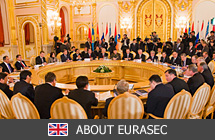

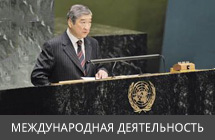

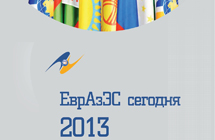
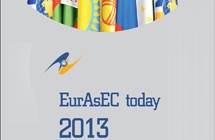
Поиск 10.10.2014 Заседание Межгосударственного совета ЕврАзЭС07.10.2014 Мультимедийная пресс-конференция в агентстве «Россия сегодня»03.10.2014 Встреча с Послом Финляндской Республики04.08.2014 Встреча Генерального секретаря ЕврАзЭС с Послом Республики Таджикистан20.06.2014 Премии Петербургского международного юридического форума «За вклад в развитие правовой интеграции на евразийском пространстве»28.05.2014 Договор о Евразийском экономическом союзе – важнейшее событие в новейшей истории наших стран25.05.2014 Презентация книги «Евразийский проект Нурсултана Назарбаева, воплощенный в жизнь. К 20-летию евразийского проекта 1994–2014»24.05.2014 VII АСТАНИНСКИЙ ЭКОНОМИЧЕСКИЙ ФОРУМ. Панельная сессия «Евразийской экономической интеграции – 20 лет. Итоги и перспективы»24.05.2014 VII Астанинский экономический форум и II Всемирная Антикризисная конференция, 21-23 мая 2014 года, Астана24.05.2014 Петербургский международный экономический форум, 23 – 24 мая 2014 года, Санкт-Петербург |

Евразийское экономическое сообщество
ЕврАзЭС
-
Страны участники
 Беларусь
Беларусь
-
 Казахстан
Казахстан
-
 Кыргызстан
Кыргызстан
-
 Россия
Россия
-
 Таджикистан
Таджикистан
-
 Узбекистан
Узбекистан
-
 Молдова
Молдова
-
 Украина
Украина



